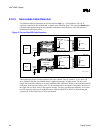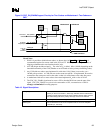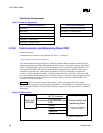
Intel
®
820E Chipset
R
86 Design Guide
Clocking is provided from the primary codec on the link via BITCLK, and is derived from a
24.576 MHz crystal or oscillator. Refer to the primary codec vendor for the crystal or oscillator
requirements. BITCLK is a 12.288 MHz clock driven by the primary codec to the digital controller
(ICH2) and any other codec present. This clock is used as the time base for latching and driving data.
The ICH2 supports Wake on Ring from S1-S5 via the AC’97 link. The codec asserts SDATAIN to wake
the system. To provide wake capability and/or caller ID, standby power must be provided to the modem
codec.
The ICH2 has weak pull-downs/pull-ups that are enabled only when the AC-Link Shut Off bit in the
ICH2 is set. This keeps the link from floating when the AC-link is off or when no codec is present.
If the shut-off bit is not set, it implies that there is a codec on the link. Therefore, BITCLK and
AC_SDOUT will be driven by the codec and ICH2, respectively. However, AC_SDIN0 and AC_SDIN1
may not be driven. If the link is enabled, it can be assumed that there is at least one codec. If there is one
or no codec on board, then the unused AC_SDINx pin(s) should have a weak (10 kΩ) pull-down to keep
it from floating.
2.13.1. AC’97 Audio Codec Detect Circuit and Configuration Options
The following provides general circuits to implement a number of different codec configurations.
Please refer to Intel’s White Paper Recommendations for ICHx/AC’97 Audio (Motherboard and
Communication and Network Riser) for Intel’s recommended codec configurations.
To support more than two channels of audio output, the ICH2 allows for a configuration where two audio
codecs work concurrently to provide surround capabilities. To maintain data-on-demand capabilities, the
ICH2 AC’97 controller, when configured for 4 or 6 channels, will wait for all the appropriate slot request
bits to be set before sending data in the SDATA_OUT slots. This allows for simple FIFO
synchronization of the attached codecs. It is assumed that both codecs will be programmed to the same
sample rate, and that the codecs have identical (or at least compatible) FIFO depth requirements. It is
recommended that the codecs be provided by the same vendor, upon the certification of their
interoperability in an audio channel configuration.
The following circuits (shown in Figure 51 through Figure 54) show the adaptability of a system with the
modification of R
A
and R
B
combined with some basic glue logic to support multiple codec
configurations. This also provides a mechanism to make sure that only two codecs are enabled in a given
configuration and allows the configuration of the link to be determined by the BIOS so that the correct
PnP IDs can be loaded.


















